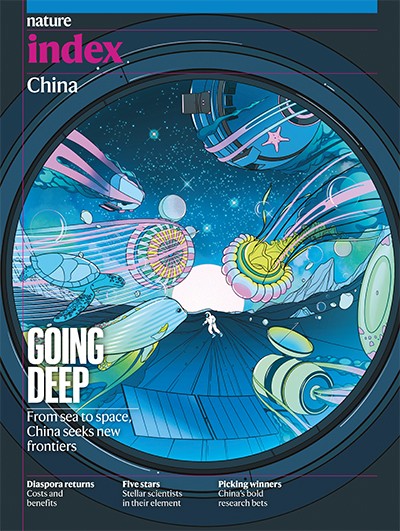
Addressing challenges such as the COVID-19 pandemic demands scientific collaboration across national borders.Credit: Douglas Magno/AFP/Getty
The COVID-19 pandemic has provided striking demonstrations of the value of research cooperation across borders. From sharing SARS-CoV-2 genome sequences to piecing together how the virus behaves, international research teams have worked together to the benefit of all.
At the same time, there are signs that mounting geopolitical tensions — particularly between the United States and China — might be diminishing the exchange of people and knowledge between nations. As countries move to protect their own interests, effort is needed on all sides to strike an appropriate balance that safeguards the great rewards that flow from mutually beneficial cooperation between researchers.
The stakes could not be higher. Problems such as climate change, environmental degradation and infectious diseases cannot be addressed fully without global scientific collaboration. International research teams help lower-income countries to build the knowledge required to sustain progress; they also help wealthier nations to pursue equitable, inclusive research based on diverse sources.
Regional collaborations — which are encouraged by the European Union and much-needed in Africa — are likewise crucial to collective science advancement.
Scientists in China say US government crackdown is harming collaborations
An analysis1 of more than 10 million papers tracked by Web of Science found that the number of internationally co-authored papers rose from 10.7% to 21.3% between 2000 and 2015. By 2015, some 200 countries were represented in the collaborative literature. But there is a risk that a golden era of open scientific cooperation is coming to an end.
In 2018, the FBI warned that China was exploiting the open research and development environment in the United States. A tsunami of investigations by the National Institutes of Health and other federal agencies identified hundreds of federally funded scientists suspected of breaking the rules on disclosing foreign ties. Although many were later exonerated, several were found guilty or are facing charges.
The United States is not alone. Japan, Australia, the United Kingdom, Germany and India have also increased their scrutiny of international research relationships in the interests of protecting national security, with China widely understood to be the country of primary concern.
Research leaders are worried that researchers in Western nations are shying away from collaborations with those in China, partly for fear of being caught up in geopolitical tensions, and also because of the administrative burden of complying with beefed-up regulations.
In Australia, higher-education enrolments from China are down compared with pre-pandemic levels. In the United States, although student intake from China held steady in the 2019–20 academic year compared with the previous one, the number of scholars visiting from China on temporary visas fell. Pandemic-related travel restrictions mean it is not possible to blame geopolitics alone. But the publication record also suggests that collaborations between the United States and China might be under threat.
An analysis published in this issue shows zero growth between 2019 and 2020 in US–China co-authored publications in the Nature Index, which tracks the author affiliations in 82 natural-sciences journals selected by reputation. By contrast, during the previous four years the growth was more than 10% annually. Publications co-authored by researchers in China and Germany, the United Kingdom, Australia and Japan all increased during the same period. (Nature Index is published by Springer Nature; Nature is editorially independent of its publisher.)
Studies that look at a broader swathe of journals also hint that collaborations between the United States and China are changing.
An analysis of science and engineering papers in the Scopus database shows that international collaboration on COVID-19-related research in the first five months of 2020 — including that between the United States and China — was higher than the average for the previous five years across all subjects2. On non-COVID-19 research, the proportion of China’s collaborations that were with the United States was lower during those months compared with the previous five years, although this might be because collaborations with other countries rose, or because some collaborations switched to focus on COVID-19.
US universities call for clearer rules on science espionage amid China crackdown
A later study shows that China–US collaborations in COVID-19 research dropped as the pandemic wore on3. This could be due to China’s lower publication rate on the topic as infections there waned, political obstacles, or both.
As more data accumulate, researchers, institutions and governments must all play their part to guard against a chill in scientific collaboration. Countries erecting barriers need to set unified and consistent research-security guidelines to give researchers the confidence to collaborate across borders. China, meanwhile, could help to ease tensions by providing greater transparency, in particular about the workings of Chinese science, its policy motivations and priorities, and how decisions are made.
In a landmark speech on science and technology in September, Chinese President Xi Jinping urged scientists to “adhere to the supremacy of the national interest”, but also highlighted the need for international cooperation. As China’s scientific strength grows, so, too, does the responsibility on all sides to retain a clear-eyed view of the global benefits of collaboration relative to any risks.


 US universities call for clearer rules on science espionage amid China crackdown
US universities call for clearer rules on science espionage amid China crackdown
 Scientists in China say US government crackdown is harming collaborations
Scientists in China say US government crackdown is harming collaborations
 US political crackdown spurs fears of Chinese brain-drain
US political crackdown spurs fears of Chinese brain-drain







